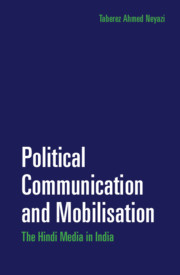Book contents
- Frontmatter
- Dedication
- Contents
- List of Figures, Tables and Maps
- Preface
- Acknowledgements
- Chapter 1 Introduction: Political Communication and Mobilisation in India
- Chapter 2 Under Colonial Rule: Mobilisation in the Hindi and English Press
- Chapter 3 Media and Mobilisation in Independent India
- Chapter 4 Localisation, Grassroots Mobilisation and Hindi News Media
- Chapter 5 Political Economy of the Hindi Press
- Chapter 6 The Hybrid Media System, Anti-corruption Movement and Political Mobilisation
- Chapter 7 Agenda-setting and Mobilisation in a Hybrid Media Environment
- Chapter 8 Conclusion: Politics, Power and Mobilisation in Digital India
- Bibliography
- Index
Chapter 7 - Agenda-setting and Mobilisation in a Hybrid Media Environment
Published online by Cambridge University Press: 17 August 2019
- Frontmatter
- Dedication
- Contents
- List of Figures, Tables and Maps
- Preface
- Acknowledgements
- Chapter 1 Introduction: Political Communication and Mobilisation in India
- Chapter 2 Under Colonial Rule: Mobilisation in the Hindi and English Press
- Chapter 3 Media and Mobilisation in Independent India
- Chapter 4 Localisation, Grassroots Mobilisation and Hindi News Media
- Chapter 5 Political Economy of the Hindi Press
- Chapter 6 The Hybrid Media System, Anti-corruption Movement and Political Mobilisation
- Chapter 7 Agenda-setting and Mobilisation in a Hybrid Media Environment
- Chapter 8 Conclusion: Politics, Power and Mobilisation in Digital India
- Bibliography
- Index
Summary
The 2014 Indian national election is considered unprecedented not least because of the extraordinary performance of the Narendra Modi-led Bharatiya Janata Party (BJP) and the formation of the first single-party majority government at the centre after 25 years. There was also an unprecedented use of new media and social networks, especially to mobilise support particularly by Narendra Modi and the digital unit in the BJP, compared to the Congress party which, unlike the BJP, did not boast about having a digital strategy in 2014. This has led scholars and commentators to regard the 2014 election as the first social media election. Narendra Modi's extensive use of both online and traditional media for campaigning has been dubbed ‘maidan to media’ (‘from field to media’), referring to the greater emphasis on media than on traditional ways of campaigning in India, such as rallies and meetings (Sardesai, 2014). Narendra Modi used social media as an important feature in his campaign strategy, but it was only one part of his overall campaign strategy. This chapter unravels the hybrid logic involved in Mr Modi's election campaign that creatively combined the logic of older and newer media and integrated it with traditional campaigns that use grassroots mobilisation, rallies and volunteer activism, both within and outside India. The 2014 election campaign was not just about Mr Modi, but about a new era in political communication practices in India where professional campaign managers, journalists, volunteer activists, entertainment media and ordinary citizens together played an important role. The Congress party and its campaign leader Rahul Gandhi had a professional firm advising on campaign strategy. The extraordinary performance of the Narendra Modi-led BJP in the Hindi heartland, where the party won 183 of the 218 seats in the region, gave the BJP an absolute majority in Parliament with a total of 282 seats. The Hindi heartland assumed significance during the campaign not only because of its electoral significance, but because most of the controversies in the run-up to the national election – including communal riots – that took place in the region.
Did the political parties succeed in getting their issues across in the media? In this chapter, I assess the battle for the news agenda and the agenda-setting power of the political parties to shape the news agenda drawing on content analysis of primetime television news on the most popular Hindi channel, Aaj Tak.
- Type
- Chapter
- Information
- Political Communication and MobilisationThe Hindi Media in India, pp. 161 - 185Publisher: Cambridge University PressPrint publication year: 2017



